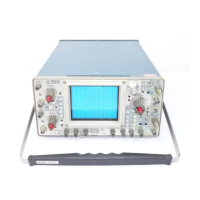Theory of Operation—465B Service
When the BEAM FI ND push button is pressed,
+15
volts
is removed from the
junction of
R4167 and R4361,
and
—8
volts is
applied
to
the junction through
R4075.
The
following actions occur:
1. The base voltage
of
Q4269C and Q4269D is
lowered to decrease
the
current
through
the two
transistors. The
reduced
current flow decreases the
voltage drop across R4266 and R4267 and the diode
clamps
(CR4266 and CR4267)
clamp
at a
much lower
voltage. This
action limits
the
horizontal deflection on
the crt; and
2. R41 67 and R4361 are now no longer connected to
+15
volts, therefore less
current flows through these
resistors. This compensates for the
decreased current
flowing through Q4269C and Q4269D and maintains
the output stage in a linear operating region.
Output Amplifier
The
push-pull signal
from the Gain Setting Cascode
Amplifier is connected to the bases of Q4169 and Q4362,
through R4265 and R4360 and on
to
the
bases
of Q4161
and Q4361. At lower sweep frequencies, the signal path is
through
R4265 and R4360 to
the
bases of Q4161 and
Q4361. These transistors
are
inverting amplifiers whose
collector signals drive the emitters of complementary
amplifiers Q4146-Q4150
and
Q4341-Q4343, respectively.
Capacitor C4262 provides
emitter
peaking for fast ac
signals. Capacitors C4150 and C4341 transfer part of the
high-frequency signal to the emitters of Q4146 and Q4342
to
maintain
the
gain of the
output stage at
high
sweep
speeds. Resistors R4244-R4250 and R4254-R4341 are the
feedback elements,
with
C4246and C4247 providing high-
frequency
compensation.
As frequency
of
the
sweep
signal increases, the
reactance
of
C4246 and C4247
decreases and feedback current increases. To compen-
sate for the increase in drive required to maintain the gain
of the output stage, Q4169 and Q4362 (fast-path
amplifiers) increase signal current to the bases of Q4161
and Q4361. High-frequency
signal
current is shunted
around
R4265
by
C4165
and R1
165,
and
C4361
and R4363
shunt high-frequency signal current around R4369. The
Output Amplifiers are limited from being over-driven by
CR4267 and CR4266.
If the
output
signal
from U4269D or
U4269C
becomes
too
large, the diodes become forward
biased
and prevent further increase in the signal level.
These diodes operate mainly to clampthe
signal
whenever
the X10 Magnification circuitry is operating. The signal
level is limited
to
the forward drop across the diodes plus
the drop across R4266
and
R4267.
CRT CIRCUIT
Introduction
The CRT circuit provides the voltage levels
and
control
circuitry necessary for
operation of the cathode-ray tube
(crt). Figure
3-9
shows a
detailed block diagram of the
CRT circuit.
High-Voltage Oscillator
The high-voltage oscillator is comprised of Q14009and
associated circuitry. It produces the drive for high-voltage
transformer T4015. When the instrument is turned on.
transistor
Q4008
is
forward biased
and
conducts through
the base
circuit of Q14009
to
forward bias Q14009. The
increasing collector
current
of Q14009, through the
primary winding of T4015, induces a
voltage
across
the
feedback
winding. Because the feedback winding is
connected
to
the base of Q14009 and the feedback is
positive, the collector current
increases rapidly toward
saturation. Soon
the
rate of increase
slows
to
a point
where the voltage induced in the feedback winding
starts
to decrease. This decreases the current through
Q14009,
further decreasing the feedback voltage. The
cycle
con-
tinues
until Q
1 4009 turns off, and
the magnetic field
around the primary winding
of
T4015
starts to
collapse.
Transistor Q14009 is held otf until the field has collapsed
sufficiently to allow the base of Q14009 to become biased
into conduction and the cycle is repeated.
The voltage waveform at the collector of Q14009 is a
sinusoidal wave at the resonant frequency of T4015. The
amplitude of sustained oscillations depends on the
average current delivered to the base of Q14009. Frequen-
cy
of
oscillation is approximately 50 kilohertz. Fuse F4508
protects
the unregulated
+15 volt supply in the event the
High-Voltage Oscillator stage
becomes
shorted.
C4006
and L4006 decouple the unregulated +15 volt supply to
prevent
current changes (present in the High-Voltage
Oscillator) from affecting the +15 volt supply
High-Voltage Regulator
Once the output voltage from the High-Voltage
Oscillator has reached its stable level after the instrument
isturned on, regulation occurs as follows. A sample of the
-2450
volt
crt
cathode
supply is applied to the base of
Q4228 through R4127D
which,
with
the
voltage
supplied
by the bias network composed of
R4332, R4127C, C4327,
and CR4329, sets the forward bias
on
Q4228. Any change
in
the
-2450
volts changes the conduction level of Q4228
to
produce
a
proportional
dc
change
on its collector.
@
3-20

